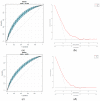Predictive Effects of FT3/FT4 on Diabetic Kidney Disease: An Exploratory Study on Hospitalized Euthyroid Patients with T2DM in China
- PMID: 37626708
- PMCID: PMC10452238
- DOI: 10.3390/biomedicines11082211
Predictive Effects of FT3/FT4 on Diabetic Kidney Disease: An Exploratory Study on Hospitalized Euthyroid Patients with T2DM in China
Abstract
Objective: This study aims to explore the correlation between the free-triiodothyronine (FT3)-to-free-thyroxine (FT4) ratio (FT3/FT4) and diabetic kidney disease (DKD) in patients with type 2 diabetes mellitus (T2DM).
Methods: This study retrospectively analyzed 1729 patients with T2DM hospitalized in the Department of Endocrinology, Peking University International Hospital, from January 2017 to August 2021, including 1075 males and 654 females. In accordance with the FT3/FT4, the patients were divided into three groups.
Results: (1) The levels of glycosylated hemoglobin (HbA1c), fasting blood glucose (FBG) and postprandial blood glucose (PBG) among the three groups were significantly different, with the low FT3/FT4 group having the highest HbA1c, FBG and PBG among the three groups (F = 39.39, p < 0.01; F = 27.04, p < 0.01; F = 5.76, p = 0.03; respectively). (2) The proportion of DKD is the highest in the low FT3/FT4 group and the lowest in the high FT3/FT4 group (χ2 = 25.83, p < 0.01). (3) Logistic regression showed that low FT3/FT4 were independent risk factors for DKD (OR = 2.36, 95 CI% 1.63, 3.43; p = 0.01).
Conclusion: A decrease in the FT3/FT4 is an independent predictor of DKD occurrence in patients with T2DM.
Keywords: diabetic kidney disease; glycosylated hemoglobin; inflammation; thyroid hormone; type 2 diabetes mellitus.
Conflict of interest statement
The authors declare no conflict of interest.
Figures


Similar articles
-
Association between FT4/FT3 ratio and microalbuminuria in euthyroid patients with type 2 diabetes mellitus.Sci Rep. 2025 Mar 1;15(1):7324. doi: 10.1038/s41598-025-92046-0. Sci Rep. 2025. PMID: 40025096 Free PMC article.
-
The effect of Central and peripheral thyroid resistance indices on diabetic retinopathy: a study of hospitalized euthyroid patients with T2DM in China.Ann Med. 2023;55(2):2249017. doi: 10.1080/07853890.2023.2249017. Epub 2023 Aug 26. Ann Med. 2023. PMID: 37634057 Free PMC article.
-
Lower Free Thyroxine Levels Are Associated with Diabetic Kidney Disease in Males with Type 2 Diabetes Mellitus: An Observational Cross-Sectional Study.Biomedicines. 2024 Oct 17;12(10):2370. doi: 10.3390/biomedicines12102370. Biomedicines. 2024. PMID: 39457682 Free PMC article.
-
Association Between Thyroid Parameters and Subclinical Atherosclerosis in Hospitalised Euthyroid Patients with Type 2 Diabetes Mellitus.Diabetes Metab Syndr Obes. 2023 Oct 12;16:3163-3171. doi: 10.2147/DMSO.S429941. eCollection 2023. Diabetes Metab Syndr Obes. 2023. PMID: 37849978 Free PMC article.
-
Correlation between diabetic peripheral neuropathy and thyroid hormone sensitivity in elderly patients with type 2 diabetes mellitus.World J Diabetes. 2025 Feb 15;16(2):98897. doi: 10.4239/wjd.v16.i2.98897. World J Diabetes. 2025. PMID: 39959265 Free PMC article.
Cited by
-
Type 2 Diabetes Mellitus in Patients with Different Types of Thyroid Nodular Lesions Among Western Romanian Patients: A Comprehensive Clinical, Biochemical, and Hormonal Analysis.Medicina (Kaunas). 2025 Jul 14;61(7):1270. doi: 10.3390/medicina61071270. Medicina (Kaunas). 2025. PMID: 40731899 Free PMC article.
-
Association between FT4/FT3 ratio and microalbuminuria in euthyroid patients with type 2 diabetes mellitus.Sci Rep. 2025 Mar 1;15(1):7324. doi: 10.1038/s41598-025-92046-0. Sci Rep. 2025. PMID: 40025096 Free PMC article.
-
The FT3/FT4 Ratio as a Metabolic Marker of Frailty and Prognosis in Older Adults with Heart Failure.J Clin Med. 2025 Jul 8;14(14):4840. doi: 10.3390/jcm14144840. J Clin Med. 2025. PMID: 40725539 Free PMC article.
-
The Correlation Between Impaired Thyroid Hormone Sensitivity and Diabetic Nephropathy in Euthyroid Patients with Type 2 Diabetes Mellitus.Diabetes Metab Syndr Obes. 2025 Apr 23;18:1207-1221. doi: 10.2147/DMSO.S507750. eCollection 2025. Diabetes Metab Syndr Obes. 2025. PMID: 40291540 Free PMC article.
-
Correlation between thyroid hormone sensitivity and diabetic peripheral neuropathy in euthyroid patients with type 2 diabetes mellitus.Sci Rep. 2024 Aug 23;14(1):19603. doi: 10.1038/s41598-024-70673-3. Sci Rep. 2024. PMID: 39179647 Free PMC article.
References
LinkOut - more resources
Full Text Sources

